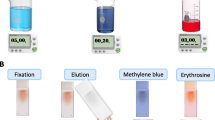Summary
A method using reverse-phase high-performance liquid chromatography (HPLC) for the identification of fetal hemoglobin (Hb F) and the simultaneous estimation of bloodstain age is described. Umbilical cord and neonatal bloodstains can be differentiated from adult stains by the presence of γ-globin chains which are characteristic of Hb F. With this method, cord and neonatal blood could be distinguished from adult blood in stains up to 32 weeks old. The age of the stain was estimated from the ratio of the peak area of the α-globin chain to that of heme on the same chromatogram. The ratio decreased gradually with an increase in the age of the stain up to 20 weeks old. Studies performed at each time period revealed no significant difference in the ratios of cord and neonatal bloodstains or in the ratios of cord and adult stains. The regression equation calculated from the ratios (y) and the ages of stains in weeks (x) expressed logarithmically isy = 2.5758 − 0.2497 ln(x) and the coefficient of correlation is −0.7491 (n = 252,P < 0.001). The present method, having the advantages of simplicity, speed and sensitivity, should be of great value to forensic science.
Zusammenfassung
Beschrieben wird eine „reverse-phase” — HPLC-Methode für die Identifizierung von fetalem Hämoglobin (Hb F) und zur gleichzeitigen Bestimmung des Blutspuren-Alters. Blutspuren von Blut aus Nabelvenen und von Neugeborenen können von Blutspuren erwachsener Personen durch die Anwesenheit der γ-Globin-Ketten differenziert werden, welche für Hb F charakteristisch sind. Mit Hilfe dieser Methode gelang die Differenzierung zwischen bis zu 32 Wochen alten Blutspuren aus Nabelschnüren und Neugeborenen einerseits und von Erwachsenen andererseits. Das Alter der Spur wurde bestimmt aus dem Verhältnis der Peak-Fläche, der α-Globin-Kette zu jener des Häm auf demselben Chromatogramm. Das Verhältnis dieser beiden Flächen nahm mit zunehmendem Alter der Blutspur graduell ab, — dies bis zu einem Spurenalter von 20 Wochen. Studien, welche zu jenem Zeitpunkt durchgeführt wurden, deckten keine signifikanten Unterschiede in diesen Peak-Verhältnissen von Nabelvenen- und Neugeborenen-Blutspuren und auch nicht in den Verhältnissen von Nabelvenen und Erwachsenen-Spuren auf. Die Regressions-Gleichung, welche von den Verhältnissen (y) und dem Alter der Spuren in Wochen (x) errechnet und logarithmisch ausgedrückt wird, lautet:y = 2.5758 − 0.2497 ln(x) und der Korrelations-Koeffizient beträgt −0.7491 (n = 252,P < 0.001). Die vorliegende Methode, welche einfach, schnell und empfindlich ist, sollte für die forensischen Wissenschaften von großem Interesse sein.
Similar content being viewed by others
References
Weinig E (1954) Eine Methode zur Altersbestimmung von Blut- und Spermaflecken. Dtsch Z Gerichtl Med 43:1–10
Kleihauer E, Stein G, Schmidt G (1967) Beitrag zur Altersbestimmung von Blutflecken. Arch Kriminol 140:84–94
Kind SS, Patterson D, Owen GW (1972) Estimation of the age of dried blood stains by a spectrophotometric method. Forensic Sci 1:27–54
Kind SS, Watson M (1973) The estimation of blood stain age from the spectrophotometric properties of ammoniacal blood stain extracts. Forensic Sci 2:325–332
Wakatsuki R (1989) Spectrophotometric analysis for the estimation of bloodstain age. Act Crim Japon 55:177–197
Yanagida J, Hara M, Nakamura H, Yoshimura K, Hasekura H (1978) Estimation of age of dried bloodstains by a surface absorption spectrophotometric method. J Saitama Med School 5:221–225
Tomita K, Yoshida H (1988) The surface absorption spectrophotometric investigation of bloodstains on various cloths. Rep Nat Res Inst Police Sci: Res Forensic Sci 41:173–181
Rajamannar K (1977) Determination of the age of bloodstains using immunoelectrophoresis. J Forensic Sci 22:159–164
Tsutsumi A (1981) Studies on the determination of the age of blood stains: 1. Estimation of the age of bloodstains left standing at room temperature. Kawasaki Igakkaishi 7:191–196
Brinkmann B, Söder R, Brinkmann M (1979) Estimating the age of bloodstains by measuring enzyme activities. Eighth International Meeting of the Gesellschaft für forensische Blutgruppenkunde, London, pp 191–196
Tsutsumi A, Yamamoto Y, Ishizu H (1983) Determination of the age of bloodstains by enzyme activities in blood cells. Jpn J Legal Med 37:770–776
Miki T, Kai A, Ikeya M (1987) Electron spin resonance of bloodstains and its application to the estimation of time after bleeding. Forensic Sci Int 35:149–158
Inoue H, Takabe F, Maeno Y, Iwasa M (1989) Identification of fetal hemoglobin in blood stains by high performance liquid chromatography. Z Rechtsmed 102:437–444
Shelton JB, Shelton JR, Schroeder WA (1984) High performance liquid chromatographie separation of globin chains on a large-pore C4 column. J Liq Chromatogr 7:1969–1977
Lee HC (1982) Identification and grouping of bloodstains. In: Saferstein R (ed) Forensic science handbook. Prentice-Hall, Englewood Cliffs, NJ, pp 267–337
Oepen I (1988) Identification of characteristics in blood and semen stains — a review. Forensic Sci Int 36:183–191
Inoue H, Takabe F, Takenaka O, Iwasa M, Maeno Y (1990) Species identification of blood and bloodstains by high-performance liquid chromatography. Int J Leg Med 104:9–12
Schroeder WA, Huisman THJ (1980) The chromatography of hemoglobin; clinical and biochemical analysis, vol 9. Marcel Dekker, New York Basel
Dickerson RE, Geis I (1983) Abnormal human hemoglobins. In: Dickerson RE, Geis I (eds) Hemoglobin: structure, function, evolution, and pathology. Benjamin/Cummings, Menlo Park, pp 117–168
Kutlar F, Kutlar A, Huisman THJ (1986) Separation of normal and abnormal hemoglobin chains by reversed-phase high-performance liquid chromatography. J Chromatogr 357:147–153
Author information
Authors and Affiliations
Rights and permissions
About this article
Cite this article
Inoue, H., Takabe, F., Iwasa, M. et al. Identification of fetal hemoglobin and simultaneous estimation of bloodstain age by high-performance liquid chromatography. Int J Leg Med 104, 127–131 (1991). https://doi.org/10.1007/BF01369715
Received:
Revised:
Issue Date:
DOI: https://doi.org/10.1007/BF01369715




